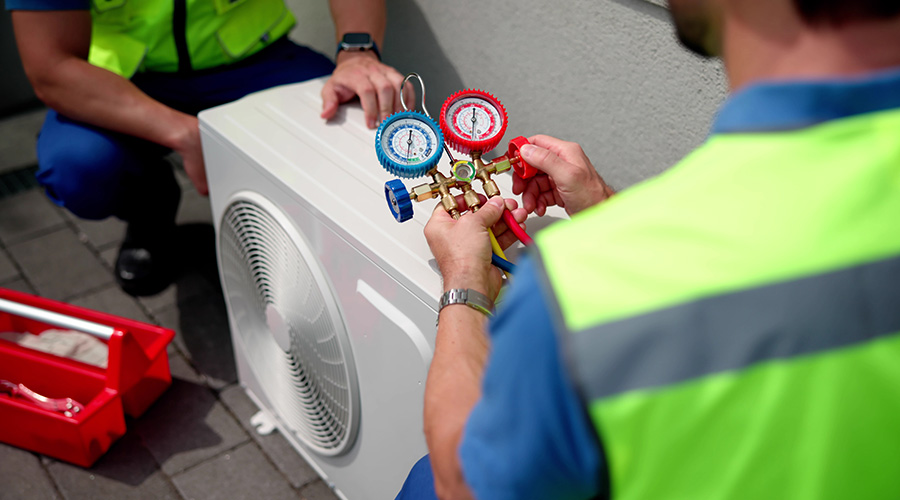From cleanliness and accessibility to heavy wear, wayfinding and promoting a healing environment — hospitals face many daily demands. Your flooring is no exception, and it’s a crucial part of creating a safe a durable care setting. In this article, we’ll examine hospital flooring options for various areas of your facility and explore the core requirements that your floors must meet.
Entrance areas
Entrances are the first area patients, families and visitors see in your hospital. They help your patrons locate services, and they see the heaviest foot traffic and rolling loads. You’ll want a durable, welcoming floor that promotes your design vision and makes a strong first impression.
Terrazzo and luxury vinyl tile (LVT) for entrance areas will go a long way in helping achieve these goals. Terrazzo is a premium, highly durable option that requires minimal maintenance and lasts for decades. It stands up well to rolling loads, is handicap-friendly and is now available in largely recyclable materials. LVT offers much of the same durability and even more design versatility.
Corridors and clinical areas
Corridors are the main arteries of your hospital and see heavy use 24-7, including foot traffic and heavy rolling loads, such as equipment carts, stretchers, med carts and wheelchairs. To minimize disruptions, flooring in corridors require highly durable material that minimize maintenance and promote slip-resistance to avoid unwanted injury. While no flooring option can 100 percent ensure that slips and falls will never occur, choosing a non-slip flooring solution will go a long way in minimizing that risk.
Rubber and LVT are two popular hospital flooring options that meet these performance requirements. Both save time during installation, as they can come with pre–applied adhesive on the backings. Free-floating LVT options even cut out adhesives altogether. Both rubber and LVT can come with protective coatings that resist scratches and scuffs, reducing maintenance disruptions, labor, water and chemicals. Both come in a variety of textures, colors and patterns. LVT in particular emulates soothing natural textures, such as wood, stone and more, but with better durability and a lower price than that of traditional materials.
Emergency and operating rooms
Emergency and operating rooms must meet the most strict infection control requirements and remain usable 24-7. You’ll want easy-to-clean materials that promote cleanliness. Using smooth or low-texture flooring and proper installation keeps dirt and fluids from slipping beneath the surface of your floor.
LVT, sheet and linoleum are great fits for these environments because they enable the use of heat welding and flash coving during installation, making it possible to create a fully aseptic space. All of these materials can come with coatings that resist chemical staining from medical products and bodily fluids. You’ll get a floor that eliminates polishing, waxing and spray buffing — reducing maintenance disruptions and costs. These materials come in constructions that promote indoor air quality with low emissions of volatile organic compounds (low VOC).
Cafeterias
The best cafeteria floors are stain-resistant, easy to clean and slip-retardant. A patterned, textured floor can benefit your cafeteria by both reducing and hiding scuffs and scratches. Evidence-based design dictates hospital cafeterias should be comfortable environments that promote relaxation and reduce stress.
Hospital flooring options that meet all of these requirements include sheet vinyl, LVT and tile. Both afford great design versatility with vibrant colors and natural textures while providing lasting durability.
Nurse’s stations and treatment areas
Staff and patients spend most of their time in these environments, and nurse’s stations never shut down. Flooring should promote stress reduction, comfort and 24-7 access with materials that allow rapid installation and minimize maintenance.
To suit these purposes, many hospitals have moved away from traditional linoleum and vinyl composition tile (VCT) for nurse’s stations and functional treatment areas. Instead, hospitals are turning to LVT, bio-based tile (BBT) and sheet tile flooring made from low-VOC materials. We recommend flooring options within these categories that have protective coatings, as they’ll resist scratches and minimize the need for waxing, buffing and chemical cleaning. Free-floating LVT and materials with adhesive backings will reduce installation times and disruption to these critical care areas.
Patient rooms
In many hospitals, patient rooms are designed to emulate home-like environments. As these rooms do not require aseptic flooring, you have more options for materials, adhesives and installation methods. You have the flexibility to specify warm, inviting flooring with natural textures.
LVT, linoleum and sheet tile are great options that provide stone, wood, tweed and other natural looks with more durability at a lower cost than natural materials. They can all work with rapid installation systems. One new option to consider is textile flooring, a material that provides the feel of carpet with the durability and performance of tile.
Mitchell Bryant is the communications specialist at Spectra Contract Flooring, a commercial flooring contractor.

 State of the Facilities Management Industry in 2025
State of the Facilities Management Industry in 2025 City of Hope to Open New Cancer Specialty Hospital in California
City of Hope to Open New Cancer Specialty Hospital in California Montefiore Einstein Opening New Inpatient Center for Youth in the Bronx
Montefiore Einstein Opening New Inpatient Center for Youth in the Bronx Skill Stacking: How Micro-Credentials Are Reshaping Trades
Skill Stacking: How Micro-Credentials Are Reshaping Trades Prima Medicine Opens New Location in Tysons, Virginia
Prima Medicine Opens New Location in Tysons, Virginia